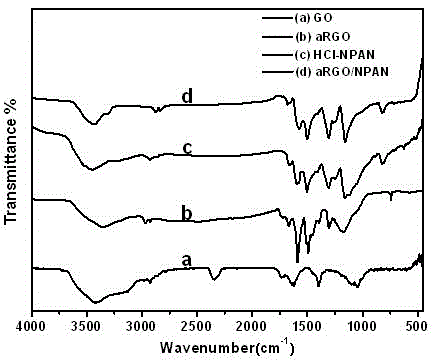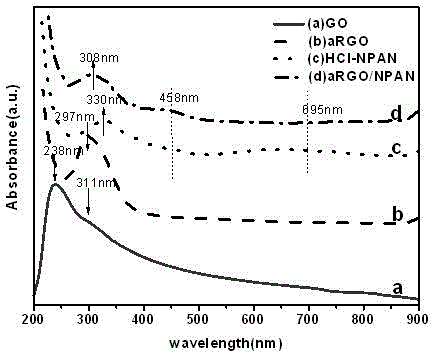Preparation method of N-substituted carboxylic acid polyaniline covalently grafted graphene composite material
A technology of covalent grafting and composite materials is applied in the field of preparation of N-substituted carboxylic acid polyaniline covalently grafted graphene composite materials, and can solve the problems of poor compatibility of composite materials, low product purity, and difficulty in popularization and use. , to achieve the effect of inhibiting agglomeration, universal applicability, and improving solubility
- Summary
- Abstract
- Description
- Claims
- Application Information
AI Technical Summary
Problems solved by technology
Method used
Image
Examples
Embodiment 1
[0038] This example will illustrate that the method of the present invention uses graphene oxide and p-aminodiphenylamine at a mass ratio of 1:5 to functionalize and partially reduce GO, and then use ammonium persulfate as an oxidizing agent, and the ratio of RGO and N-phenylglycine The mass ratio is 1:2, which is realized according to the chemical oxidation polymerization reaction path.
[0039] GO (100 mg) prepared by the Hummer method was dispersed in 100 ml of DI and sonicated for 30 min to present a uniform dispersion. In a 50ml beaker, dissolve 0.5g of p-aminodiphenylamine (ADPA) in a mixture of 20ml of concentrated hydrochloric acid and 20ml of absolute ethanol (about 6M HCl), and sonicate until dissolved (about 15min). Under ice-water bath, 0.228g of NaNO2 was dissolved in 75ml of ice DI to form a solution. Slowly drop into the above mixture, and continue to stir at this temperature for half an hour after the drop; then slowly drop the above GO dispersion into the ice...
Embodiment 2
[0043] This example will illustrate that the method of the present invention uses graphene oxide and p-aminodiphenylamine at a mass ratio of 1:5 to functionalize and partially reduce GO, and then use ammonium persulfate as an oxidizing agent, and the ratio of RGO and N-phenylglycine The mass ratio is 1:1, which is realized according to the chemical oxidation polymerization reaction path.
[0044] GO (100 mg) prepared by the Hummer method was dispersed in 100 ml of DI and sonicated for 30 min to present a uniform dispersion. In a 50ml beaker, dissolve 0.5g of p-aminodiphenylamine (ADPA) in a mixture of 20ml of concentrated hydrochloric acid and 20ml of absolute ethanol (about 6M HCl), and sonicate until dissolved (about 15min). Under ice-water bath, 0.228g of NaNO2 was dissolved in 75ml of ice DI to form a solution. Slowly drop into the above mixture, and continue to stir at this temperature for half an hour after the drop; then slowly drop the above GO dispersion into the ice...
Embodiment 3
[0048] Repeat Example 1, but change the mass ratio of graphene oxide and p-aminodiphenylamine to 1:2 to obtain a composite material conductivity of 1.3×10 -1 S / cm.
PUM
| Property | Measurement | Unit |
|---|---|---|
| Conductivity | aaaaa | aaaaa |
| Conductivity | aaaaa | aaaaa |
| Conductivity | aaaaa | aaaaa |
Abstract
Description
Claims
Application Information
 Login to View More
Login to View More - R&D
- Intellectual Property
- Life Sciences
- Materials
- Tech Scout
- Unparalleled Data Quality
- Higher Quality Content
- 60% Fewer Hallucinations
Browse by: Latest US Patents, China's latest patents, Technical Efficacy Thesaurus, Application Domain, Technology Topic, Popular Technical Reports.
© 2025 PatSnap. All rights reserved.Legal|Privacy policy|Modern Slavery Act Transparency Statement|Sitemap|About US| Contact US: help@patsnap.com



